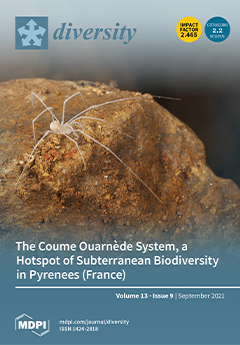The evolutionary trajectories of insects and angiosperms appear to be intimately interconnected. Increases in the diversity of phytophagous beetles and angiosperms co-occur in the Mesozoic fossil record, and there is fossil evidence of pollinivory and pollination by insects, both in flowering plants and
[...] Read more.
The evolutionary trajectories of insects and angiosperms appear to be intimately interconnected. Increases in the diversity of phytophagous beetles and angiosperms co-occur in the Mesozoic fossil record, and there is fossil evidence of pollinivory and pollination by insects, both in flowering plants and in gymnosperms. The oldest records of angiosperm pollination indicate flies as pollen vectors. A basal group of angiosperms, the order Magnoliales, has retained plesiomorphic characters such as dozens of pistils and stamens spiraling around the receptacle. In a family of this order, Annonaceae, over 90% of species are pollinated by beetles. In many Annonaceae species, flowers display wide spaces, referred to as floral chambers, where beetles can find shelter from weather conditions and predators, food in the form of pollen and tissues, and a mating site. Two basic types of floral chambers can be distinguished: small chambers visited by small beetles (Nitidulidae, Staphylinidae, Chrysomelidae, and Curculionidae) with diurnal and/or nocturnal activity and large and thermogenic floral chambers visited by beetles of the tribe Cyclocephalini (Scarabaeoidea, Melolonthidae). In the latter case, the heat that the flowers produce may serve as a resource for the beetles that visit them, resulting in smaller endothermy costs for the scarabs. This study reviewed the literature including PhD and MSc theses on cantharophilous Annonaceae in the
Cerrado. In this biome, both types of associations are found, although cantharophilous Annonaceae represent a small portion of the plant species (<5%). Cantharophilous Annonaceae in the
Cerrado share attributes according to the beetles that pollinate them: species pollinated by small beetles, for instance, may flower throughout the year, whereas Annonaceae pollinated by Cyclocephalini normally flower in the beginning of the rainy season (October/November), in synchrony with the phenological patterns of their pollinators. Cantharophilous Annonaceae flowers, regardless of their size, tend to have light colors and sweet and fruity odors. In addition to the lack of studies on the attraction of beetles by these floral characters, the taxonomic composition of the beetles that pollinate Annonaceae in the
Cerrado is poorly known. This review attempts to discuss, in light of what has already been published, potential fields of investigation concerning pollinating beetles’ behavior and evolution.
Full article





